
Totem poles are monumental carvings found in western Canada and the northwestern United States. They are a type of Northwest Coast art, consisting of poles, posts or pillars, carved with symbols or figures. They are usually made from large trees, mostly western red cedar, by First Nations and Indigenous peoples of the Pacific Northwest Coast including northern Northwest Coast Haida, Tlingit, and Tsimshian communities in Southeast Alaska and British Columbia, Kwakwaka'wakw and Nuu-chah-nulth communities in southern British Columbia, and the Coast Salish communities in Washington and British Columbia.

The Museum of Anthropology at the University of British Columbia (UBC) campus in Vancouver, British Columbia, Canada displays world arts and cultures, in particular works by First Nations of the Pacific Northwest. As well as being a major tourist destination, MOA is a research and teaching museum, where UBC courses in art, anthropology, archaeology, conservation, and museum studies are given. MOA houses close to 50,000 ethnographic objects, as well as 535,000 archaeological objects in its building alone.
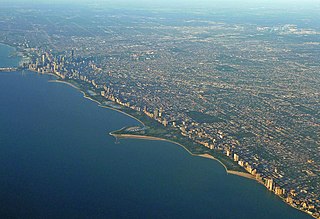
Lincoln Park is a 1,208-acre (489-hectare) park along Lake Michigan on the North Side of Chicago, Illinois. Named after US President Abraham Lincoln, it is the city's largest public park and stretches for seven miles (11 km) from Grand Avenue, on the south, to near Ardmore Avenue on the north, just north of the DuSable Lake Shore Drive terminus at Hollywood Avenue. Two museums and a zoo are located in the oldest part of the park between North Avenue and Diversey Parkway in the eponymous neighborhood. Further to the north, the park is characterized by parkland, beaches, recreational areas, nature reserves, and harbors. To the south, there is a more narrow strip of beaches east of Lake Shore Drive, almost to downtown. With 20 million visitors per year, Lincoln Park is the second-most-visited city park in the United States, behind Central Park.
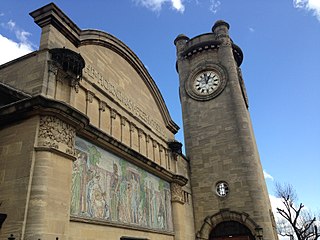
The Horniman Museum and Gardens is a museum in Forest Hill, London, England. Commissioned in 1898, it opened in 1901 and was designed by Charles Harrison Townsend in the Modern Style. It has displays of anthropology, natural history and musical instruments, and is known for its large collection of taxidermied animals. The building is Grade II* listed.

The Royal British Columbia Museum, founded in 1886, is a history museum in Victoria, British Columbia, Canada. The "Royal" title was approved by Queen Elizabeth II and bestowed by HRH Prince Philip in 1987, to coincide with a royal tour of that year. The museum merged with the British Columbia Provincial Archives in 2003.
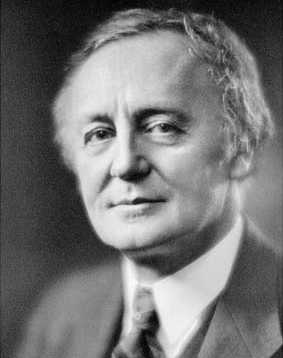
Charles Marius Barbeau,, also known as C. Marius Barbeau, or more commonly simply Marius Barbeau, was a Canadian ethnographer and folklorist who is today considered a founder of Canadian anthropology. A Rhodes Scholar, he is best known for an early championing of Québecois folk culture, and for his exhaustive cataloguing of the social organization, narrative and musical traditions, and plastic arts of the Tsimshianic-speaking peoples in British Columbia, and other Northwest Coast peoples. He developed unconventional theories about the peopling of the Americas.
The Ganhada is the name for the Raven "clan" (phratry) in the language of the Tsimshian nation of British Columbia, Canada, and southeast Alaska. It is considered analogous or identical to the G̱anada (Raven/Frog) Tribe of the Nisga'a nation in British Columbia and the Frog clan among B.C.'s Gitxsan nation. The Gitxsan also sometimes use the term Laxsee'le to describe the Frog clan.
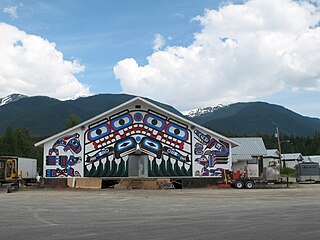
Gitlax̱t'aamiks, formerly New Aiyansh, is a Nisga'a village about 100 km (62 mi) north of Terrace, in the heart of the Nass River valley, Canada. It is one of four Nisga'a villages. Though it is located in British Columbia, it is also considered the "capital of the Nisga'a Nation". The Nisg̱a'a Lisims Government building, which opened in 2000, is located here. The area is home to 806 people and the Nisga'a Memorial Lava Bed Provincial Park. Gitlax̱t'aamiks is located overlooking a lava flow that erupted in the 18th century. The source for this lava flow was the Tseax Cone.
Coast Mountain College (CMTN) is an accredited, publicly-funded post-secondary educational institution that serves the communities of British Columbia's northwest region. CMTN offers field schools, college access, trades, university credit, health and human services programs. The college is a member of the University of the Arctic network, and Colleges and Institutes Canada (CiCan).
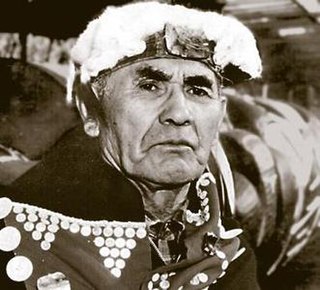
Chief Mungo Martin or Nakapenkem, Datsa, was an important figure in Northwest Coast style art, specifically that of the Kwakwaka'wakw Aboriginal people who live in the area of British Columbia and Vancouver Island. He was a major contributor to Kwakwaka'wakw art, especially in the realm of wood sculpture and painting. He was also known as a singer and songwriter.

George Hunt (Tlingit) was a Canadian and a consultant to the American anthropologist Franz Boas; through his contributions, he is considered a linguist and ethnologist in his own right. He was Tlingit-English by birth and learned both those languages. Growing up with his parents at Fort Rupert, British Columbia in Kwakwaka'wakw territory, he learned their language and culture as well. Through marriage and adoption he became an expert on the traditions of the Kwakwaka'wakw of coastal British Columbia.
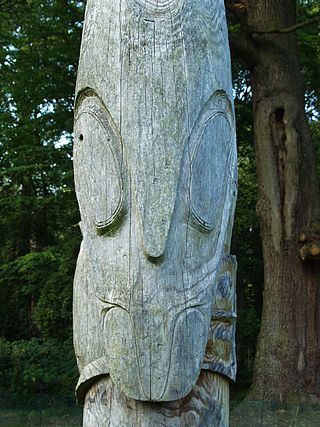
Norman Tait was a Nisga'a First Nations sculptor and totem pole carver from northwestern British Columbia, Canada.

Kwanusila is a 12.2 meter tall totem pole carved from red cedar. It stands in Lincoln Park at Addison Street just east of Lake Shore Drive in the Lake View neighborhood of Chicago, Illinois. The colorfully painted totems include a grimacing sea monster at the bottom, a man riding a whale above it, and Kwanusila the Thunderbird on top.
Ron Joseph Telek was a Canadian First Nations sculptor. He is a member of the Laxsgiik of the Nisga'a nation of northwestern British Columbia, and carries the hereditary name of Jagam Txalp meaning Four Canoes Coming into the Village. Telek's primary medium for his sculptures is wood, although he also includes other materials such as bone, moose hair and abalone into his work.

Ellen Neel (1916–1966) was a Kwakwakaʼwakw artist woodcarver and is the first woman known to have professionally carved totem poles. She came from Alert Bay, British Columbia, and her work is in public collections throughout the world.

The Nisg̱aʼa Museum is a museum of the Nisg̱aʼa people that is located in Lax̱g̱altsʼap, a village in northwestern British Columbia, Canada. The Nisg̱aʼa name means "the heart of Nisg̱aʼa House crests," a name that celebrates the role of tribal crests in Nisg̱aʼa society. The museum is a project of the Nisg̱aʼa Lisims Government and opened in the spring of 2011. It is a place for display of Nisg̱aʼa artifacts, sharing traditions and ideas, and a centre for research and learning. The museum's collection of Nisg̱aʼa culture is "one of the preeminent collections of Northwest Coast aboriginal art" The museum's website states: "This is our gift to each other, our fellow Canadians and the world."

The Nisga'a and Haida Crest Poles of the Royal Ontario Museum are a collection of four large totem poles, hand carved from western red cedar by the Nisga’a people and Haida people of British Columbia's coast. The poles are referred to as: Three Persons Along (Nisga'a); the Pole of Sag̱aw̓een (Nisga'a); the Shaking Pole of Kw’ax̱suu (Nisga'a); and House 16: Strong House Pole (Haida). Each of the crest poles tell a family story, as carved figures represent crests that commemorate family history by describing family origins, achievements and experiences. These memorial poles were typically placed in front of the owners' house along the beach.

The Haida Heritage Centre is the premier cultural centre and museum of the Haida people. It is located in Skidegate, a community on Graham Island in Haida Gwaii off the Pacific coast of British Columbia, Canada. The centre is situated just south of the site of a historical village in Kay Llnagaay. The Centre was built and is managed by Gwaalagaa Naay, an economic development branch of the Skidegate Band Council, the owners of the site. It is one of the major aboriginal cultural tourism attractions in Haida Gwaii and has been described as "a place for the Haida voice to be heard." Educational programs are offered in partnership with School District 50 Haida Gwaii, the University of Northern British Columbia, and with the Haida Gwaii Higher Education Society.

James Hart is a Canadian and Haida artist and a chief of the Haida Nation.
Tim Paul is a member of the Hesquiaht tribe from the Nuu-Chah-Nulth first nation. He is a master carver from Esperanza Inlet British Columbia. He was the senior carver at the Royal British Columbia Museum until 1992 when he left to oversee an indigenous education program for the Port Alberni school board on Vancouver Island.



















